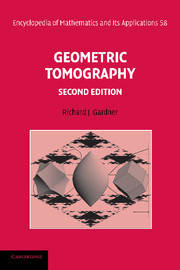Book contents
- Frontmatter
- Contents
- Preface to the second edition
- Preface
- 0 Background material
- 1 Parallel X-rays of planar convex bodies
- 2 Parallel X-rays in n dimensions
- 3 Projections and projection functions
- 4 Projection bodies and volume inequalities
- 5 Point X-rays
- 6 Chord functions and equichordal problems
- 7 Sections, section functions, and point X-rays
- 8 Intersection bodies and volume inequalities
- 9 Estimates from projection and section functions
- Appendixes
- References
- Notation
- Author index
- Subject index
0 - Background material
Published online by Cambridge University Press: 05 June 2013
- Frontmatter
- Contents
- Preface to the second edition
- Preface
- 0 Background material
- 1 Parallel X-rays of planar convex bodies
- 2 Parallel X-rays in n dimensions
- 3 Projections and projection functions
- 4 Projection bodies and volume inequalities
- 5 Point X-rays
- 6 Chord functions and equichordal problems
- 7 Sections, section functions, and point X-rays
- 8 Intersection bodies and volume inequalities
- 9 Estimates from projection and section functions
- Appendixes
- References
- Notation
- Author index
- Subject index
Summary
This chapter introduces notation and terminology and summarizes aspects of the theories of affine and projective transformations, convex and star sets, and measure and integration appearing frequently in the sequel.
Some passages are designed to ease the beginner into these areas, but not all the material is elementary. It is intended that the reader start with Chapter 1, and use the present chapter as a reference manual. For Chapter 1, the requisite material is included in the first four sections of this chapter only, and for Chapter 2, the requisite material is included in the first five sections only.
Basic concepts and terminology
This section is a brief review of some basic definitions and notation. Any unexplained notation can be found in the list at the end of the book.
Almost all the results in this book concern Euclidean n-dimensional space En. The origin in En is denoted by o, and if x ∈ En, we usually label its coordinates by x = (x1, …, xn).(In E2 and E3 we often use a different letter for a point and label its coordinates in the traditional way by x, y, and z.) The Euclidean norm of x is denoted by ∥x∥, and the Euclidean scalar product of x and y by x · y. The closed line segment joining x and y is [x, y].
- Type
- Chapter
- Information
- Geometric Tomography , pp. 1 - 27Publisher: Cambridge University PressPrint publication year: 2006



